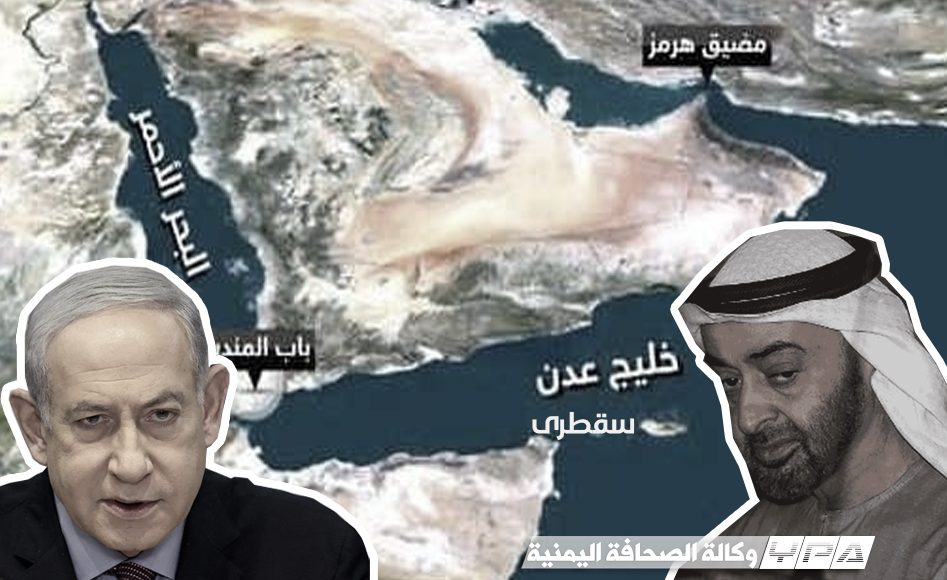SANAA, Nov. 19 (YPA) – It is no longer a secret that the 2020 normalization of relations between the UAE and the Israeli entity legitimized an Israeli presence on strategic Yemeni islands that were seized by the Saudi-led coalition forces during the war on Yemen since March 2015, under an Emirati cover, despite these islands being far from the frontlines with Sanaa forces.
The war on Yemen has taken on deeper, more dangerous security and military dimensions than the coalition’s declared pretexts and objectives. This is particularly evident on Mayon Island in the Bab al-Mandab Strait, where the UAE established a military base and airstrip in late 2016, and on the Socotra Archipelago, where surveillance centers linked to marine submarines with espionage technology were established in late 2020 in the “Ras Qatinan” and “Jamjumoh” areas of Moomi, facing the Arabian Sea, Gulf of Aden, and Bab al-Mandab.
From ‘Abd al-Kuri’ Island to ‘Zuqar’ Island
The Israeli-Emirati presence expanded to Abd al-Kuri Island in the Socotra Archipelago following an Emirati displacement plan against the island’s residents and the construction of an airstrip starting in December 2021. This is due to the island’s strategic location overlooking international shipping lanes linking Europe and Asia. Airstrips were also marked out in early 2025, and in March, the UAE moved to establish an airstrip and military installations for equipment and soldiers on Zuqar Island, which is about 32 km from the Yemeni coast and 150 km from Bab al-Mandab. This forms an integrated hostile equation against Sanaa forces following their participation in supporting Gaza by imposing a two-year ban on Israeli navigation in the Red Sea.
The Last Card in the Conspiracy
In the face of Emirati, Israeli, and American maritime movements, Britain recently pushed Saudi Arabia to assert its presence in the Red Sea through a maritime security conference. This is seen as a final card, along with the UAE, to secure Israeli navigation under the pretext of “protecting international navigation”—a justification that Washington’s warships and aircraft carriers failed to uphold against Zionist vessels.
However, what is different at the present time is the direct foreign threat to the security of the countries overlooking the Red Sea, most notably Yemen, Egypt, Djibouti, Sudan, as well as Saudi Arabia, which is foolishly heading towards sinking what remains of the Kingdom to the bottom of the sea.
The Eritrean President, Isaias Afwerki, recently sounded the alarm in November, describing the concerning Emirati-Israeli military movements in the Red Sea as a “conspiracy” to change the region’s geopolitical map. He explicitly warned that foreign powers are attempting to establish dominance, pointing to efforts to build bases on the Yemeni islands of Socotra, Mayon, and Zuqar, and linking these moves to attempts to “Balkanize” Somalia. Afwerki warned that these schemes pose a “constant danger” to the Red Sea, Gulf of Aden, and Indian Ocean coasts, calling for coordinated regional efforts.
Security and Stability of the Region
Afwerki’s warnings, coming from a key regional player, suggest that the danger posed by Western states and “Israel” threatens not only Yemen but the security and stability of all Red Sea littoral states. This conflict is internationally driven to secure Israeli maritime interests, especially after Yemeni forces replicated the naval blockade imposed by Egypt during the 1973 October War. The core of the plot lies in Yemen’s islands—the “secret word”—which are being used as a staging ground for a military presence backed by the US and “Israel”, as confirmed by Afwerki’s stance against foreign bases on Eritrean soil.
In order for the strategic island of Mayon to be under the direct administration of the Zionist entity, or to friendly forces, according to old and renewed warnings issued by the Zionist entity’s foreign minister, Abba Eban, during June 1966, who said: “If Mayyun falls into hands not friendly to Israel, a dangerous situation may arise,” due to its connection to the shipping route to the occupied port of Umm al-Rashrash “Eilat,” the occupation was able to distance the Yemeni state from its geographical location in the Bab al-Mandab Strait and the Yemeni islands since 1967 AD, and when the Yemeni President Ibrahim al-Hamdi at time tried to strengthen the military garrison in Mayon and hold a conference of the countries bordering the Red Sea, he was assassinated.
Yemen at the Core of the Equation
In reality, President Afwerki did not deliver a protocolary speech about the security and stability of Yemen, which he placed at the heart of the Red Sea equation. This is because the instability in Yemen and the Red Sea region is linked to the desire of global powers, backed by America, “Israel”, and Britain, and their use of regional proxies, to consolidate their military presence. This presence is based on the Yemeni islands, which have been the key to the conspiracies targeting Yemen, its land, and its people. Afwerki’s statements align with Eritrea’s policy of refusing to allow foreign military bases on its territory, unlike Djibouti, which hosts approximately 11 foreign military bases. There are also genuine concerns stemming from Addis Ababa’s landlocked ambitions, particularly its recent attempt to gain access to the sea through the Somali port of Berbera.
By linking the Emirati scenario for the fragmentation of Somalia, and its acquisition of the “Somaliland” region, which it turned into a joint military base with “Israel” in exchange for promises of secession and achieving what is called “independence” from the Somali state, Abu Dhabi is trying to replicate this on southern Yemen, and bring its partner “Israel” to the heart of the Yemeni islands, which it currently views as areas of influence and a pivotal point in its upcoming battle with the Yemeni forces in Sanaa, after the latter carried out hundreds of naval operations against the Israeli occupation.
The islands of Mayon, Zuqar, Socotra, and Abd al-Kuri have become occupied islands since the declaration of war on Yemen by the coalition countries, which created puppet governments under the name of “legitimacy,” without objecting to the coalition’s serious violations in the Yemeni islands.
The Yemeni Deterrence Equation
The growing concern and warnings from the heads of state and governments of Red Sea littoral countries about the militarization of the region represent a belated realization. This comes after the warnings repeatedly issued by the leader of the revolution, Sayyed Abdul-Malik Badr al-Din al-Houthi, in most of his speeches from the outset, that the war on Yemen, especially with the start of the confrontations on the western coast, has as its primary objective “control over the islands, coastal cities, ports, and also the Bab al-Mandab Strait due to its global strategic importance. All the events and problems stemming from this are aimed at achieving this main objective of the aggressor forces.”
However, the question that arises at this stage is: how long will the political and military leaders loyal to the coalition continue to silently observe the international game being played out over Yemen’s waters and islands, as if it doesn’t concern them? This compels that government to return to the right path before it pays a heavy price for its complicity with the enemies of the land and the Yemeni people.
Therefore, what is happening in the Yemeni islands and the Bab al-Mandab Strait cannot be understood apart from the deterrence equation of the Yemeni forces supporting the people of Gaza during the past two years by banning Israeli navigation in the Red Sea, reaching the point of disrupting the occupied port of Umm al-Rashrash “Eilat” in the Gulf of Aqaba, which constituted a strategic shift in the regional and international balance of power, and what is happening in the Yemeni islands amidst repeated hints from the Zionist entity about preparations for a new military aggression against Sanaa, was not separate from the past ten years of the war on Yemen.
Thus, we conclude that the increasing foreign presence on Mayon, Zuqar, Socotra, and Abd al-Kuri islands is not separate from the military equation imposed by Sanaa forces to support Gaza by blocking Israeli navigation, which has disrupted the occupied port of Eilat, and the continued occupation of the Yemeni islands and the surrounding international game are viewed as a direct consequence of the ten-year war against Yemen.
YPA


